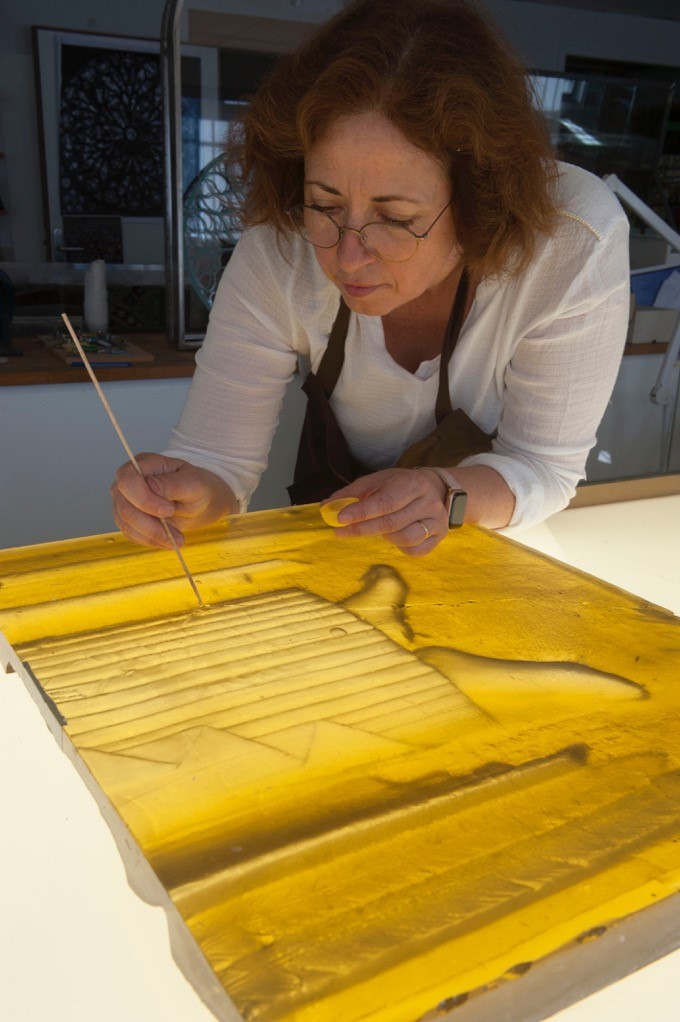Glass, angels… and a microscope
Interview with Flavie Serrière Vincent Petit – November 2023

Copyright – Pascal STRITT
In 2022, the Clément Fayat Foundation has chosen to invest in the restoration of exceptional stained glass windows, alongside the Heritage Foundation. Created by René-Jules Lalique at the beginning of the 19th century, these 30 windows depict angels, whose radiance is restored by the fingers of Flavie Serrière Vincent-Petit.
The missing angel…
The church of Saint-Nicaisede Reims will gradually regain its golden luminosity. The 11 bays on the south side of the building are currently being restored by Manufacture Vincent-Petit in Troyes. This project is led by the Association des Amis de Saint-Nicaise du Chemin-Vert. These stained glass windows are very special,” explains Flavie Serrière Vincent-Petit, curator-restorer of heritage stained glass. It was an experimental project for René Lalique, because of their height and thickness, which in places is over 4 cm. Lalique will never again make stained glass windows this thick.
In this yellow-tinted pâte de verre, the artist has drawn angels kneeling or standing. Restoring them is a technical challenge for the teams at the Manufacture: “ To keep the works of art in their original location, we manufacture a transparent double glazed roof with special locks and load-bearing devices. Installed on the outside, it will protect the Lalique windows from the elements. We also had to completely recreate a stained-glass window, as one of the 30 windows was missing. Fortunately, we know exactly which design to make, as the angels are arranged symmetrically in the church. »
The garden city social project
When asked why the Clément Fayat Foundation is sponsoring this project, Laurent Fayat, Chief Executive Officer of the Fayat Group, replied at the signing of the agreement on 20 October 2022: ” We liked everything about it, from the Lalique stained glass windows, which are pure works of art, to the social aspect of the development. »
The Saint-Nicaise church is part of an innovative post-war development, the Cité-Jardin de Reims, designed by Georges Charbonneaux. Inspired by the tradition of social Catholicism, the Chemin-Vert housing estate was designed to accommodate large families of employees from Reims in individual housing. This social complex included a children’s home, a school for mothers, a communal house with shower-baths and a library, a village hall, a vegetable garden, a henhouse and a church, for which Georges Charbonneaux called on his friend René-Jules Lalique.
At the bedside of Notre-Dame
Back to Troyes, where Flavie and her teams are busy working on Lalique’s glassworks, but that’s not all. With 26 employees, the Vincent-Petit factory brings together several stained-glass-related trades: conservation-restoration, mirror-making, locksmithing and digital cutting. “When my husband and I set up the factory in 2012, we immediately landed a major contract for the stained glass windows in Châlon Cathedral “, Flavie recalls. With a first Masters degree in conservation-restoration of glass and stained glass, this medieval history enthusiast then decided to take another Masters at the Nancy School of Architecture in “glass, design and architecture”, to “broaden my vision of a building as a whole“. Always on the lookout for new knowledge, Flavie is currently working on a thesis on gaps in stained glass and the possible intersections between heritage and contemporary creation.
Workshops of this size can be counted on the fingers of one hand in France. Recognised nationally for its expertise, the Vincent-Petit factory was one of the professionals called in urgently a week after the Notre-Dame fire in April 2019, to remove the threatened stained glass windows. His teams then won a tender to restore 24 stained-glass windows from the choir, transept and sacristy, building special 7-metre-long light tables to do the job! “Of course, we’re very proud to be part of this unprecedented mobilisation around Notre-Dame.”
Stained glass under the microscope
In order to carry out detailed examinations of the works entrusted to it, the Manufacture is equipped with electron microscopes, which provide a better understanding of alterations, as well as the manufacturing technique. For Flavie and her teams, technological assistance is essential: ” In restoration, we don’t redo things exactly as they were, we find other methods to preserve the object while keeping traces of its past. In the past, when a stained glass window was damaged, a copy of the broken pieces was made. Now we glue the broken pieces together, fill in with resin and reinstall. » To better inform its decisions, the Manufacture favours interdisciplinary approaches and works in collaboration with experts in objets d’art, ceramists, nanotechnology specialists and the research laboratory for historic monuments. Each step is carefully considered: “Restoration is always a choice, taking into account the value of the work, whether aesthetic, historical or in terms of its use… “
